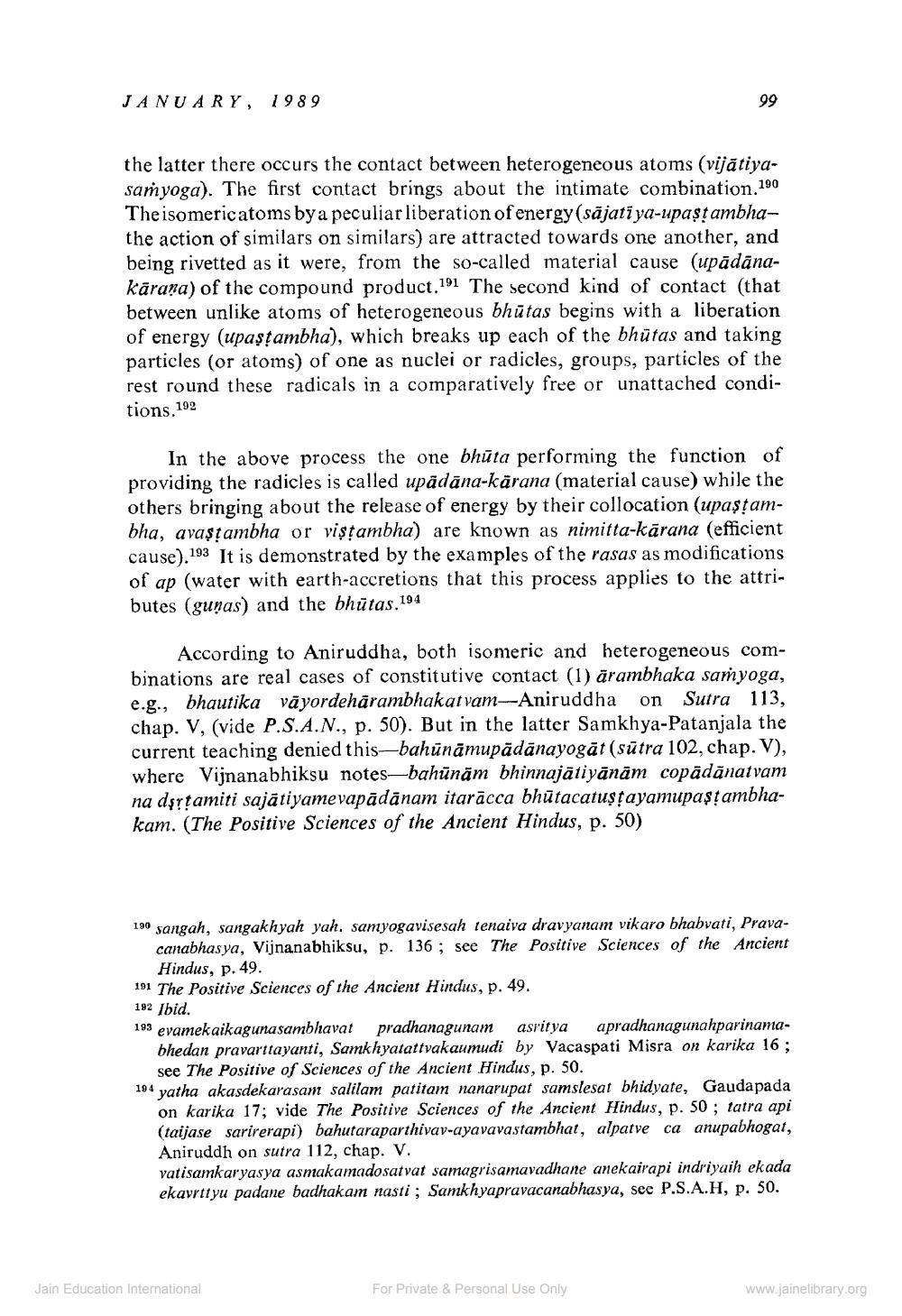________________
JANUARY, 1989
the latter there occurs the contact between heterogeneous atoms (vijātiyasamyoga). The first contact brings about the intimate combination.190 The isomeric atoms by a peculiar liberation of energy (sajati ya-upaṣṭambhathe action of similars on similars) are attracted towards one another, and being rivetted as it were, from the so-called material cause (upādānakaraṇa) of the compound product. 191 The second kind of contact (that between unlike atoms of heterogeneous bhūtas begins with a liberation of energy (upaşṭambha), which breaks up each of the bhutas and taking particles (or atoms) of one as nuclei or radicles, groups, particles of the rest round these radicals in a comparatively free or unattached conditions,192
99
In the above process the one bhūta performing the function of providing the radicles is called upādāna-kärana (material cause) while the others bringing about the release of energy by their collocation (upaṣṭambha, avaṣṭambha or viṣṭambha) are known as nimitta-karana (efficient cause).193 It is demonstrated by the examples of the rasas as modifications of ap (water with earth-accretions that this process applies to the attributes (gunas) and the bhūtas.194
According to Aniruddha, both isomeric and heterogeneous combinations are real cases of constitutive contact (1) arambhaka samyoga, e.g., bhautika vāyordehārambhakatvam-Aniruddha on Sutra 113, chap. V, (vide P.S.A.N., p. 50). But in the latter Samkhya-Patanjala the current teaching denied this-bahūnāmupādānayogāt (sutra 102, chap. V), where Vijnanabhiksu notes-bahūnām bhinnajātiyānām copādānatvam na darṭamiti sajātiyamevapādānam itaracca bhūtacatuṣṭayamupaṣṭambhakam. (The Positive Sciences of the Ancient Hindus, p. 50)
190 sangah, sangakhyah yah. samyogavisesah tenaiva dravyanam vikaro bhabvati, Pravacanabhasya, Vijnanabhiksu, p. 136; see The Positive Sciences of the Ancient Hindus, p. 49.
191 The Positive Sciences of the Ancient Hindus, p. 49.
192 Ibid.
pradhanagunam
asritya
apradhanagunahparinama
193 evamekaikagunasambhavat bhedan pravarttayanti, Samkhyatattvakaumudi by Vacaspati Misra on karika 16; see The Positive of Sciences of the Ancient Hindus, p. 50.
194 yatha akasdekarasam salilam patitam nanarupat samslesat bhidyate, Gaudapada on karika 17; vide The Positive Sciences of the Ancient Hindus, p. 50; tatra api (taijase sarirerapi) bahutaraparthivav-ayavavastambhat, alpatve ca anupabhogat, Aniruddh on sutra 112, chap. V.
vatisamkaryasya asmakamadosatvat samagrisamavadhane anekairapi indriyaih ekada ekavrttyu padane badhakam nasti; Samkhyapravacanabhasya, see P.S.A.H, p. 50.
Jain Education International
For Private & Personal Use Only
www.jainelibrary.org




